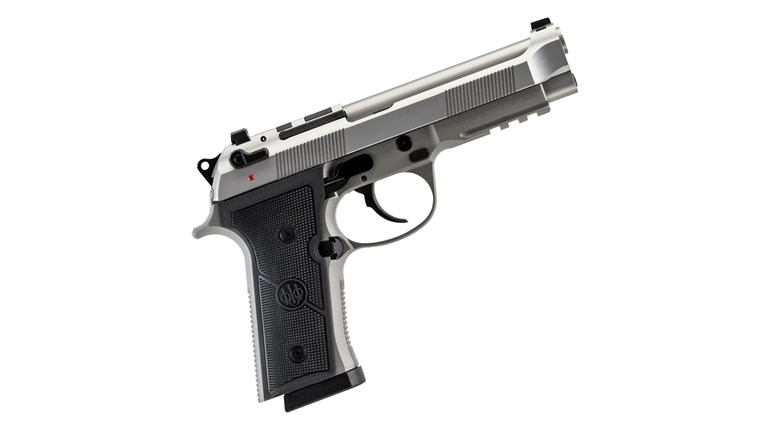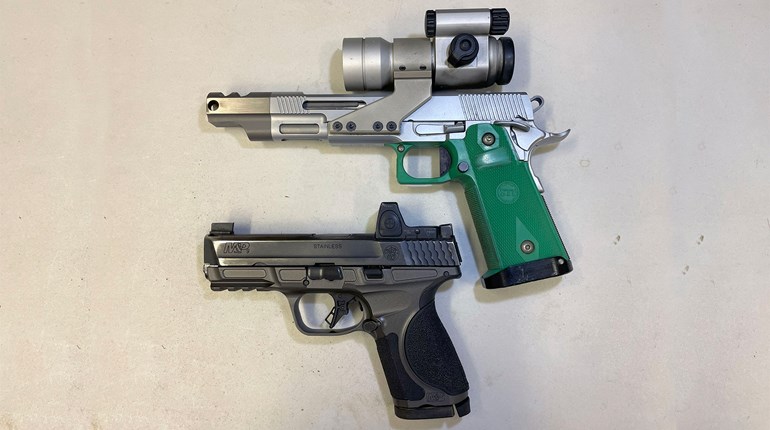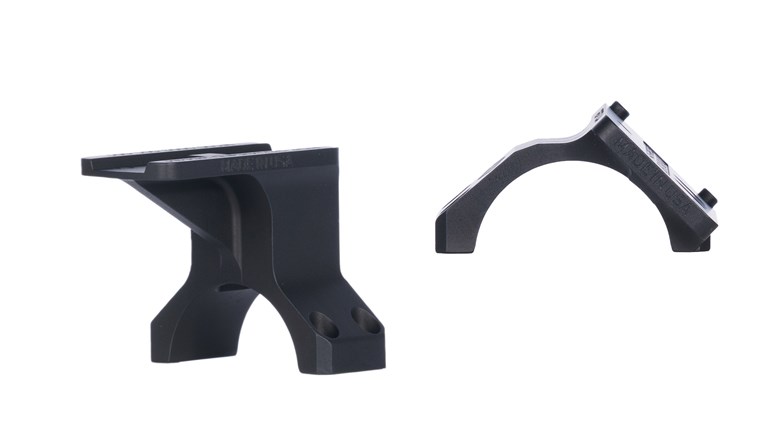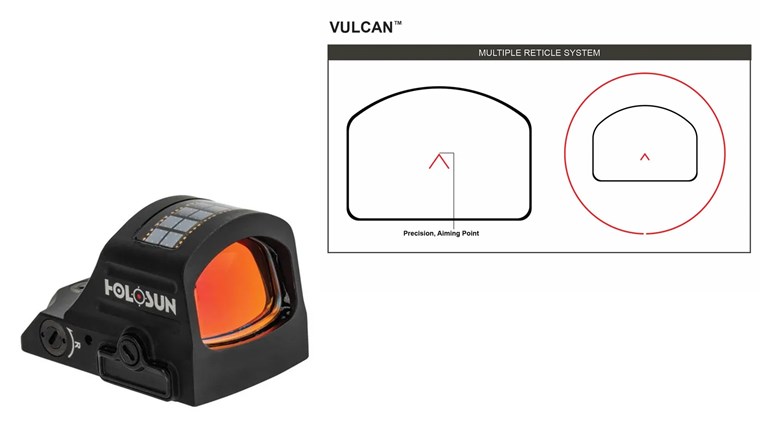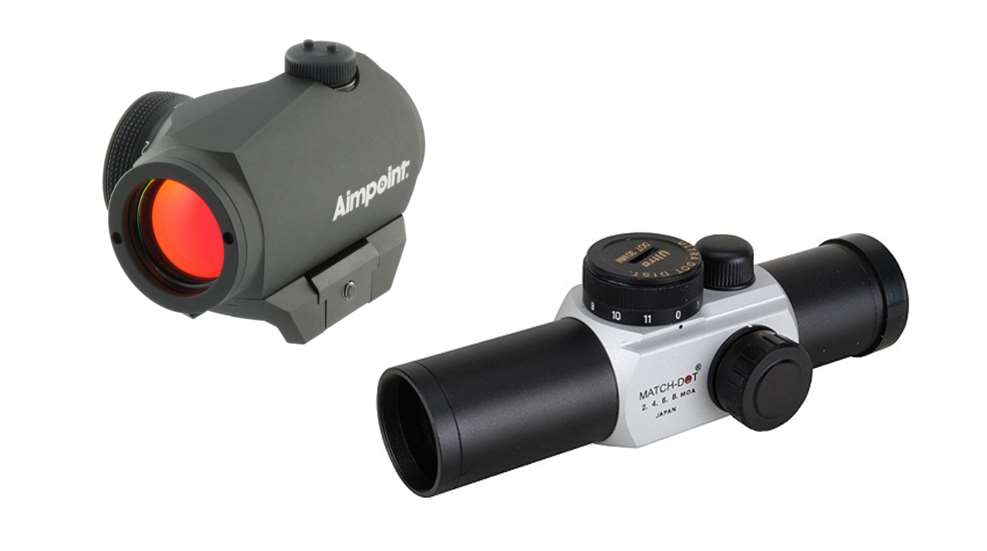
Red dot (reflex) sights were invented some time before they were picked up by pistol shooters. The principal is really pretty simple, though the implementation can be complex. In principal, the sight shines a red light onto a coated lens that reflects back the red light and lets the other colors pass through. The lens is angled to put the dot in the eye of the shooter. All this is mounted in a moveable tube, so that the relative position of the light can be adjusted to coincide with the impact point of the bullet. The theoretical focus of this reflected light is in the neighborhood of 40 feet or so, so the dot is nearly in the same plane as the target. This makes it easier to see the target and the sight clearly, without having to constantly move the shooter’s focus back and forth. This is especially helpful as the eyes age and lose some of their elasticity. This has allowed shooters to remain competitive in their later years.
The original red dot sights were first manufactured by the Swedes and were quite heavy and bulky with small tubes which limited the field of view. Most had an appendage that hung off the side to hold photographic batteries. This not only made them somewhat cumbersome, but also led to high failure rates of the batteries, since the longitudinal design caused the batteries to bang against each other in recoil. Sometime in the late 1980s a new design was developed in the U.S. using the fairly new lithium-type battery. This new design placed the battery at 90 degrees to the recoil and was much lighter and less bulky, being positioned inside the intensity knob. This is the design that is most prevalent today, though some manufacturers still use the older design. Developments in lens coatings, LED technology and adhesives have led to quite reliable sights today.
Dot size is a personal preference and the multi-dot sights are popular for that reason. The UltraDot Matchdot actually came about from team feedback. A few guys on the team wanted a small dot for 50 yards (and also for the small 50-foot indoor target), but they preferred a larger dot for the timed and rapid stages so as not to “pick” at the middle. In other words, the larger dot nearly covered the black, so if the dot was in the black, the shot would be good. Knowing that allowed them to stay on the trigger and not try to clean up the shot, making those stages run smoother.
What should you look for in a Red Dot sight?
- Quality of manufacture: These days, most anything can be copied offshore. Most quality optics come from Germany, Japan, Sweden and the United States.
- Warranty: Look for at least a two-year warranty. Most have five-year to life warranties. Read the warranty. Most are not transferable and have a cost associated with return of the sight for repair.
- Suitability for your purpose: For inclement weather, choose a closed tube type sight. If water gets on the lens, it will still be useable. With open “window” or “heads-up” type sights water can get on the back of the mirror and this can distort the dot, making it inaccurate.
- Size: Use only as much diameter as you need: Small diameters for bullseye and larger diameters for sports that require moving from target to target (ex., IPSC). Either way, the field of view is unlimited if you shoot with both eyes open.
- Mounting: Consult with your gunsmith about what type of mounting is best for your activity and pistol; frame, slide, etc. Try to get the sight as close to the bore as possible.
Notes from the repair tech:
- Leave the dot turned on for the day’s shooting. Saving wear on the control is worth the trade-off in battery life. Most sights will run up to 500 hours on a battery.
- Clean plastic lenses with soap and water and glass lenses with glass cleaner.
- Don’t place mounting rings directly over the lenses. Rings can compress the tube and cause lenses to crack under recoil.
- Place the forward ring as close to the center of the sight body as possible (right to it if you can). This takes strain from recoil off the tubes.
- Use quality batteries. Many off-brand batteries will not give full intensity or the desired lifespan.
- Find a tool that fits the battery cap and keep it handy. Once the cap has been damaged, it becomes more and more difficult to remove it each time.
- Don’t immerse the sight in water. Most are water resistant, but not water-proof. Stay especially away from cleaning solvents which may damage lens coatings and/or seep into the sight. It is a good idea to use a mounting system that returns to zero, so you can remove the sight while cleaning your firearm.
Notes from shooters:
- Use quality shooting glasses. Some polycarbonate lenses can distort the dot image.
- Use shaded glasses on bright days. Filters which attach to the sight tend to be less recoil resistant than the sight. A pair of sunglasses will never fall off your gun in a match.
- If you don’t see a round dot, ask your eye doctor if you have an uncorrected astigmatism. This is especially true if you have really good vision. The eye doctor will not normally give a prescription to correct a small astigmatism if everything else is okay. If you see what appears to be a cluster of small dots forming the dot image, your visual acuity is so good that you are actually seeing the surface of the mirror’s coating. Try focusing farther out toward the target.
- Beware of progressive lenses. A small amount of change in the angle of you head can cause you to look through a different prescription on your lens.
- Be aware that lens makers actually leave small identification numbers on the lenses. If these numbers (nearly invisible to the naked eye) are in line with the dot image, they will distort it.
Read the advice 12-time NRA National Pistol Champion Brian Zins shared about aiming the red dot sight.













